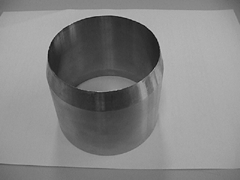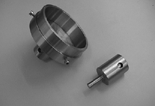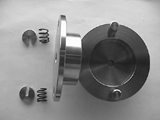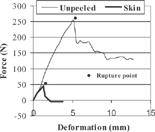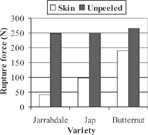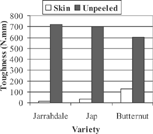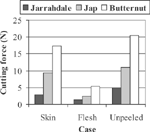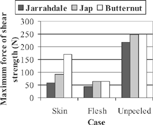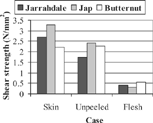Abstract
Mechanical properties of three common varieties of pumpkin were evaluated and statistically compared. Toughness, rupture force, shear strength, and cutting force were determined for Jarrahdale, Jap, and Butternut varieties. The investigation was carried out in three cases of flesh, skin and unpeeled product, ignoring the toughness and rupture force of flesh. Relative contribution of skin to unpeeled case of each property was estimated. Varieties were found statistically alike in rupture force, toughness, and maximum shear strength force of unpeeled cases. Also the skin of three varieties showed similar strength in shear (p>0.05). Jap and Butternut varieties for some other properties showed close values. Maximum shear strength force of flesh, shear strength of unpeeled case, and relative contribution of skin to shear strength of unpeeled case were close (p>0.05) for these varieties. Jarrahdale had no difference in shear strength of flesh with two other varieties. It was also similar (p>0.05) to Jap in relative contribution of skin to shear strength, rupture force, and toughness of unpeeled case.
INTRODUCTION
The study of the physical and mechanical properties of fruits and vegetables plays an important role in the development of peeling and processing equipment. The tissues of products are subjected to different desired and undesired mechanical forces and strains during these stages. The desired mechanical loading takes place basically in food processing equipment such as slicers and peelers that always are accompanied with unwanted loads. Unwanted mechanical loading (compression, impact, and vibration) is the main cause of bruising of products during post harvesting operations.[Citation1] Knowing the physical and mechanical properties of products will be useful for the purpose of increasing the effects of wanted and decreasing the effects of unwanted mechanical loading.
One of the basic and most important tests in the study of mechanical properties of fruits and vegetables is the compression test. It can reflect some of the mechanical properties of skin, flesh, and unpeeled products.[Citation2–8] In addition to the compression test, a tensile test can be carried out for the purpose of determining some skin properties such as skin strength.[Citation2] The latter method is difficult to implement because of some shortcomings, such as difficulty in the holding of skin specimen preparation.[Citation10, Citation11]
Several researchers including Grotte et al.,[Citation5] Jackman et al,[Citation2] and Voisey et al.[Citation7] have used the difference between unpeeled (overall) compression test and that of measured without skin (flesh) to obtain indirectly the result of a force-deformation test of the skin. This experimental procedure has been rejected by some researchers because of the likelihood of errors in the result. For example, Thompson et al.[Citation11] concluded that determining the contribution of the skin to the external puncture force of cucumbers by making measurements before and after skin removal is subject to error. Jackman and Stanley[Citation12] also concluded that the difference of puncture load displacement between unpeeled (overall) and without skin (flesh) products cannot provide the load displacement of the skin itself. They admitted the increase in effective area of compression during puncture with skin as a reason.
The attempts to find any published data on physical and mechanical properties of pumpkin varieties were unsuccessful. Recommendations are required on design and optimization of processing equipment after the harvest of pumpkin, especially at peeling stage. The current study was conducted on three varieties of pumpkin that have commercial importance: Jarrahdale, Jap, and Butternut. The aim was to investigate some of their physical and mechanical properties. The investigation was carried out by means of using a compression test on three different cases of product: skin, flesh, and unpeeled cases. The investigation of the skin properties was carried out directly on separated skin as well as flesh. Force-deformation behavior and rupture force for two cases of skin and unpeeled product were investigated. Toughness was calculated for both cases. Shear strength, shear, and cutting forces were evaluated for three cases of flesh, skin, and unpeeled product. Also the relative contribution of skin to unpeeled product for each property was calculated. The mean arithmetic value of each property was statistically compared for different varieties.
EXPERIMENTAL INVESTIGATION
Materials
Jarrahdale, Jap, and Butternut are three varieties of pumpkin (Cucurbitaceae family) having commercial importance that were randomly chosen from different local farms around Brisbane (Queensland, Australia). The vegetables were ripe, defect-free, and of different sizes. They were prepared for tests by keeping them under controlled laboratory conditions at least 24 hours prior to tests on the basis of ASAE standard.[Citation13] The temperature of 20-25°C and relative humidity of 50-55% were maintained as the main environmental parameters. Moisture content was measured and recorded for every vegetable before testing. Because conducting the test on the whole vegetable was impossible, the unpeeled specimens with circular shape of 80 mm in diameter and 10 mm thick (flesh depth) were prepared from whole pumpkin by using a special cutter device (). Middle layers of flesh close to the skin were chosen to pick up a circular shape of flesh specimens in 30 mm diameter and 5 mm thickness. Skin specimens were also prepared with diameter of about 30 mm with the flesh removed by means of scraping to avoid any ambient effects on test results. The specimens were prepared from the equatorial region of the whole vegetable,[Citation5–14] as well as from top and bottom regions of whole vegetable. The specimens on each diametrical circle were taken from convex and concave areas of the vegetable. Different holders were designed and fabricated for unpeeled specimens and skin specimens ( and ). The skin was held tightly during the tests with a special holder.[Citation15]
Experimental Methods and Procedures
Compression test
The tests were performed under standard condition[Citation13] using an Instron machine (Hounsfield H5000M) controlled by a PC. The geometry of the indentor tip, especially the size and shape, are suggested to be carefully considered in any mechanical test[Citation16] because the obtained results from compression tests are affected by indentor geometry[Citation6,Citation7,Citation17] and dimensions.Citation17,Citation18 Attempts have been made to standardize the above parameters as well as other test conditions such as crosshead speed. Thus, a cylindrical indentor, 8 mm in diameter, with a hemispherical end was applied.[Citation13] The ratio of diameter of indentor to the diameter of specimen was 1/10 to close the obtained results of investigation on specimen to whole vegetable. There was no significant difference in the shape of the curves for different speeds of penetration between 5 to 25 mm/min.[Citation19] The penetration speed of the indentor was chosen at 20 mm min−1, which is suggested by ASAE.[Citation13] Every experiment was repeated 20 times and averaged results were compared statistically.
Toughness
The necessary mechanical energy to break down the tissues of vegetables is called “toughness”.[Citation20] That is calculated as the area under force-deformation curve from the initial point up to the rupture point ().
Shear strength test
The shearing strength of the product indicates the degree to which the cells are held together. Shearing strength of a product is investigated by shearing a plug from a slice of the product. Knowing the shearing force, F, the diameter of the solid cylindrical die with flat end, d, and the thickness of the slice, t, shearing strength, S, is determined from[Citation15].
Tests for three different varieties of pumpkin in three cases involving skin, flesh, and unpeeled pumpkin were carried out to determine the shear strength and maximum of force in each case. Experiments were conducted randomly on samples of different sizes and from different parts of the pumpkins. A flat end indentor with a diameter 8 mm was used to shear the skin at an Instron machine with the speed of 20 mm/min. The tests were repeated at least 10 times for every case. Initially, the test was carried out on skin, which is not supported by the flesh. The flesh attached to skin was gradually removed with a knife to prepare skin samples. A special holder for skin samples was designed and constructed to hold tightly the specimen during the test. The skin samples used had diameters of at least three times that of the indentor (about 30 mm).
Cutting force test
This test was carried out to determine the necessary cutting force of a product in three different cases involving unpeeled, skin and flesh of three different varieties of pumpkin. Samples were prepared from different parts of the product and kept in the holder. A stainless steel cutting indentor with sharpened edges of 30° included angles and 1.5 mm thickness (21) was used in the Instron machine. The speed of loading was 20 mm/min. The test was repeated 10 times for every case, and averaged results were calculated and compared.
Statistical Analysis
One-Way analysis of variance (ANOVA) with post hoc comparisons with SPSS software was used for analysis of variance. Variations of mean values of each property for three varieties of pumpkin were determined by Least Significant Difference (LSD). LSD values were calculated at the 5% level.
RESULTS AND DISCUSSION
Force-Deformation Curve
Force-deformation curves for skin and unpeeled cases were obtained directly from compression test for each case. An example of these curves obtained from compression test on skin and unpeeled cases of Jarrahdale variety by spherical indentor is shown in . The initial part of the curves up to the rupture point (the first peak point) was nearly linear in both cases. After the rupture point, the force falls to zero in skin case and a lower level in unpeeled case as the indentor continues moving through the tissue. The uneven form of curvature in lower levels can be attributed to the effects of friction on the sides of indentor and tissue compression for additional displacement.
Rupture Force
The highest and the lowest rupture force (maximum force of compression) for skin and unpeeled product belonged to Butternut and Jarrahdale varieties, respectively, shown in . While the rupture force of three varieties in the unpeeled case was not significantly different (), the rupture forces of skin were significantly different (p < 0.05). The relative contributions of the skin to the forces required to puncture the product were 16.17, 22.83, and 72.86%, respectively, for Jarrahdale, Jap, and Butternut varieties. This property was not significantly different (p > 0.05) for Jarrahdale and Jap varieties (). The considerable relative contribution of the skin of the Butternut variety to necessary puncture force of unpeeled product is close to reported values for other products. Thompson et al.[Citation22] reported 58 to 88% of the same property by doing puncture tests on different fruits including avocado, Bartlett pear, and McIntosh apple and also vegetables such as eggplant, green bell pepper, slicing-type cucumber, zucchini, and squash. Also Grotte et al.[Citation5] obtained 65 to 70% of relative contribution for different varieties of apples.
Table 1 Mechanical properties of three pumpkin varieties including Jarrahdale, Jap, and Butternut in different cases (skin, unpeeled, and flesh) (Mean ± Standard Deviation)
Table 2 Relative contribution (%) of skin to different mechanical properties for three pumpkin varieties including Jarrahdale, Jap, and Butternut (Mean ±Standard Deviation)
Toughness
While the toughness of the unpeeled product decreased from Jarrahdale toward Butternut, the toughness of the skin increased in the same direction. The toughness of unpeeled Jarrahdale and Jap varieties was nearly the same as but bigger than Butternut (). The unpeeled toughness was not significantly different (p > 0.05) among the three varieties (). The skin toughness of Butternut was considerably higher than Jap and Jarrahdale, and the three varieties were significantly different (p < 0.05) in this case. The relative contributions of skin to overall toughness were 2.13, 1.8, and 22.01% for Jarrahdale, Jap, and Butternut, respectively. The outcome was not significantly different (p > 0.05) for Jarrahdale and Jap varieties (). The same property was reported for different products in different environmental conditions. Grotte et al.[Citation5] reported 45% of relative contribution of skin to the overall toughness of Golden Delicious apple at harvest. This value increased to 78% after 210 days of storage at 2°C. They measured indirectly by calculating the difference of toughness with and without skin.
Cutting Force
Generally, the necessary cutting force of skin increased from 2.82 N for Jarrahdale to 17.31N for Butternut (). The average necessary cutting force of skin of Jap was 9.41N. The increasing procedure was also repeated for the flesh and unpeeled products in the same order. The cutting forces of skin, flesh, and unpeeled product among different varieties of pumpkin were significantly different (p < 0.05) for each case (). The highest and lowest relative contributions of skin to overall necessary cutting force of unpeeled cases were calculated 85.19 and 53.88% for Jap and Jarrahdale, respectively. Butternut had a 84.95% relative contribution in this case. It was not significantly different (p > 0.05) compared to the Jap variety (). Relative contribution of skin to cutting force of unpeeled Cassava tuber can be calculated indirectly by using reported data[Citation21] between peeled and unpeeled product. It is 76% and almost closes to obtained values of Jap and Butternut varieties.
Maximum Force of Shear Strength
Maximum force of shear strength of product increased from flesh to unpeeled cases for all varieties (). Maximum shearing force of skin also increased from 57.84 to 168.68 N for Jarrahdale and Butternut, respectively. The mean of maximum shearing force of skin was significantly different (p < 0.05) among the three varieties (). While the shearing force of skin of the Jap variety (91.67 N) was less than the Butternut, the shearing force of flesh and unpeeled cases for these two varieties were nearly the same. The maximum shearing forces of flesh of Jap and Butternut were not significantly different (p > 0.05), but the Jarrahdale variety was significantly different (p < 0.05) than two other varieties in this case. The maximum shearing force of unpeeled product was quite close (p > 0.05) for three different varieties of pumpkin. The relative contributions of skin to maximum shearing force of unpeeled product were 42.56, 27.83, and 67.43%, respectively, for Jap, Jarrahdale, and Butternut varieties. The significant difference (p < 0.05) was seen among the three varieties in this case ().
Shear Strength
Generally the shear strength decreased from skin to flesh cases for all varieties except Butternut (). The shear strength of unpeeled and skin cases of Butternut was almost the same. That can be considered as the result of the high thickness of the skin compared to other varieties. A higher skin strength in shear to the unpeeled case for two other varieties with regard to smaller thickness of skin was also considerable. Shear strength of skin of the Jap was slightly higher than that of two other varieties, but there was no significant difference (p > 0.05) among the three varieties in this case (). The flesh of Butternut and Jap showed maximum and minimum strength to shear, respectively. The shear strength of flesh of Jap was significantly different (p < 0.05) than Butternut, but the difference was not significant between Jarrahdale and two other varieties (p > 0.05). The highest shear strength of skin and unpeeled cases were recorded for the Jap variety with 3.29 and 2.42 N/mm2 in order, whereas, the lowest rates for skin and unpeeled cases were recorded for Butternut (2.31 N/mm2) and Jarrahdale (1.78 N/mm2), respectively. The shear strength of unpeeled Jarrahdale was significantly different (p < 0.05) than two other varieties, while there was no significant difference (p > 0.05) between shear strength of unpeeled Jap and Butternut. The relative contribution of skin to shear strength of unpeeled product was more than 100% for all three varieties. It showed the high strength of skin to shear compare to unpeeled case, which was calculated at 153.03, 145.05, and 101.99% for Jarrahdale, Jap, and Butternut varieties, respectively. No significant difference (p > 0.05) was noted between Jap and two other varieties, while Jarrahdale and Butternut were different (). Shear strength of Butternut is closer to the same property of other products. For example, a relative contribution of about 91% can be computed for cassava tuber according to the reported data,[Citation21] between peeled and unpeeled product.
Application of Investigated Properties
The value of investigated properties can be used in the peeling stage of pumpkin processing. The ideal peeling targets remove skin without wasting the underlying good tissue. Maximum permitted rupture force to break the skin without rupturing the whole pumpkin can be considered at about 200 N. Values bigger than 200 N will lead to rupturing and wasting of whole Jarrahdale and less than that, probably would not give result in rupturing of Butternut's skin. Values of toughness indicated different necessary force to rupture the skin for different varieties. To save the energy, it should not be considered more than 22, 62, and 164 N.mm for Jarrahdale, Jap and Butternut, respectively. Cutting force and maximum shear strength force of skin showed the maximum force needed to cut through the peel without injuring the whole pumpkin. A maximum force of shear strength of 188N can be applied effectively without any harm to the whole product, except with the Jarrahdale variety, but to determine one value of cutting force for all three varieties is impossible. Injury to the variety with lower thickness as well as wasting energy are reasons to consider different cutting forces of skin (). Butternut showed the same value for shear strength of skin and unpeeled specimens due to a higher skin thickness. Higher values of shear strength for skin when compared with unpeeled products of other varieties can be a possible reason for skin toughness, which should be an important parameter in peeler design.
CONCLUSION
Some mechanical properties of three common varieties of pumpkin––Jarrahdale, Jap, and Butternut—for skin, flesh, and unpeeled cases were investigated. The rupture force and toughness for two cases of unpeeled and skin in addition to the cutting force, shear strength, and maximum force of shear strength for skin, flesh, and unpeeled cases were determined by direct compression tests for each case. The relative contribution of skin to unpeeled product was also estimated for each property. Statistical comparisons indicated that rupture force, toughness, and maximum force of shear strength are not variety features among the three different unpeeled pumpkins. Except for the shear strength of skin, other investigated properties of flesh and skin cases did not show similar values. Results of this study can be used in the design and optimization of mechanical peeling equipment and for the development of new mechanical peeling methods.
Notes
13. American Society of Agricultural Engineers. Compression test of food materials of convex shape 2001 ASAE S368.4 DEC00, 2950 Niles Road, St. Joseph, MI 49085–9659, USA.
REFERENCES
- Brusewitz , G.H. , McCollum , T.G. and Zhang , X. 1991 . Impact bruise resistance of peaches . Transactions of the ASAE , 34 ( 3 ) : 962 – 965 .
- Jackman , R.L. and Stanley , D.W. 1994 . Influence of the skin on puncture properties of chilled and nonchilled tomato fruit . Journal of Texture Studies , 25 : 221 – 230 .
- Voisey , P.W. and Lyall , L.H. 1965a . Methods of determining the strength of tomato skin in relation to fruit cracking . Proc. J. Amer. Soc. Hort. Sci. , 86 : 597 – 609 .
- Voisey , P.W. and Lyall , L.H. 1965b . Puncture resistance in relation to tomato fruit cracking . Can. J. Plant Sci. , 45 : 602 – 603 .
- Grotte , M. , Duprat , F. and Loonis , D. 2001 . Mechanical properties of the skin and the flesh of apples . International Journal of Food Properties , 4 ( 1 ) : 149 – 161 . [CROSSREF]
- Holt , C.B. 1970 . The measurement of tomato firmness with a universal testing machine . J. Texture Studies , 1 : 491 – 501 .
- Voisey , P.W. , Lyall , L.H. and Kloek , M. 1970 . Tomato skin strength-its measurement and relation to cracking . J. Amer. Soc. Hort. Sci. , 95 : 485 – 488 .
- Behnasawy , A.H. , El-Haddad , Z.A. , El-Ansary , M.Y. and Sorour , H.M. 2004 . Physical and mechanical properties of some Egyptian onion cultivars . Journal of Food Engineering , 62 : 255 – 261 . [CROSSREF]
- Su , C.S. and Humphries , E.G. 1972 . Rupture properties of cucumber skin . Pickle Pak. Sci. , 2 : 1
- Clevenger , J.T. and Hamann , D.D. 1968 . The behaviour of apple skin under tensile loading . Transactions of the ASAE , 11 : 34 – 37 .
- Thompson , R.L. , Fleming , H.P. and Hamann , D.D. 1992 . Delineation of puncture forces for exocarp and mesocarp tissues in cucumber fruit . Journal of Texture Studies , 23 : 169 – 184 .
- Jackman , R.L. and Stanley , D.W. 1992 . Area- and perimeter-dependent properties and failure of mature-green and red-ripe tomato pericarp tissue . J. Texture Stud. , 23 : 461 – 474 .
- 13. American Society of Agricultural Engineers. Compression test of food materials of convex shape 2001 ASAE S368.4 DEC00, 2950 Niles Road, St. Joseph, MI 49085–9659, USA.
- Chen , H. , Duprat , F. , Grotte , M. , Loonis , D. and Pietri , E. 1996 . Relation of the impact transmission wave to the apple texture during ripening. . J. Texture Stud. , 27 : 123 – 141 .
- Mohsenin , N.N. 1980 . Physical Properties of Plant and Animal Materials , 2nd , 238 – 241 . New York : Gordon and Breach, Science Publishers, Inc. .
- Abbott , J.A. 1999 . Quality measurement of fruits and vegetables . Postharvest Biology and Technology , 15 : 207 – 225 . [CROSSREF]
- Bourne , M.C. 1966 . Measure of compression and shear components of puncture tests . J. Food Sci. , 31 : 282 – 291 .
- Bourne , M.C. 1975 . Method of obtaining compression and shear coefficients of foods using cylindrical punches . J. Texture Studies , 5 : 459 – 469 .
- Mohsenin , N.N. and Gohlich , H. 1961 . Techniques for determination of mechanical properties of fruits and vegetables as related to design and development of harvesting and processing machinery . Journal of Pennsylvania Agricultural Experiment Station , 2687 : 300 – 315 .
- Finney , E.E. 1969 . To define texture in fruits and vegetables . Agricultural Engineering (United States) , 50 : 462 – 465 .
- Ohwovoriole , E.N. , Oboli , S. and Mgbeke , A.C.C. 1988 . Studies and preliminary design for a cassava tuber peeling machine . Transaction of the ASAE , : 380 – 385 .
- Thompson , R.L. , Fleming , H.P. and Hamann , D.D. 1992 . Delineation of puncture forces for Exocarp and Mesocarp tissues in Cucumber fruit . J. Texture. Stud. , 23 : 169 – 184 .
